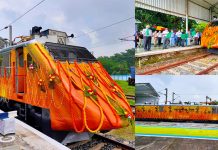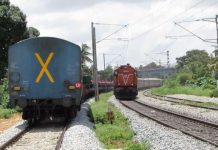The Station Master at the halt
Trains used to stop here briefly, yet the station teemed with life. Excited, noisy youngsters alighted here to walk their way to college nearby, Navy personnel and their families tugged their holdalls and metal trunks pushing their way to the compartments. There was a constant buzz.
Today, the Perumanoor railway station (originally spelt Perumanur) is abandoned, forgotten. What remains of this derelict site is the crumbling station building overrun by weeds and all that remains is ‘Station Master’ painted on the wall that indicated the entrance to the station master’s office. A small adjoining room which now stinks of garbage must have been the waiting room.
Proximity to the port
Perumanoor and Mattancherry were two halt stations on the Ernakulam-Cochin Harbour Terminus (CHT) railhead. CHT, located in Willingdon Island, was strategically important for its proximity to the Cochin Port. In fact, this station was built mainly to handle cargo from the Cochin harbour. As it is is said, no port is complete without a railway line. The CHT, just a few yards away from the quays, was the starting point of many important passenger trains and was easily accessible for the residents of West Kochi.
Till the development of CHT trains came only up to the Ernakulam Terminus that operated a metre gauge line to Shoranur. When this was converted to broad gauge the line passed through Ernakulam to Willingdon Island. Many routes were planned, studies undertaken, new stations — Ernakulam Town, Ernakulam Junction, Perumanoor, Mattancherry Halt and CHT — built along the route. Anticipating freight traffic the Venduruthy Bridge was constructed linking Willingdon Island to the mainland.
Passenger trains became operational on this route from 1943 with the introduction of the Cochin-Shoranur passenger. The introduction of the Madras-Cochin Express in 1944 elevated the status of CHT. The Tea Garden Express and Island Express, named after Willingdon Island, enhanced the significance of this route. In the course of two decades many more trains chugged through this route, passing and stopping at Perumanoor. In fact, at its peak of operation 16 trains started from CHT and plied this line.
It was a scenic ride from CHT to Ernakulam. In his travelogue Riding God’s Axe , Siva Sadasivan, writes travelling aboard the Island Express, “It steamed daily from the beautiful Harbour Terminus through Willingdon Island, with its old-world godowns (now replaced by container terminals) to Mattancherry Halt. Then it moved along beside the old Cochin Airport (now exclusively used by the Indian Navy) past Southern Naval Command headquarters, across Venduruthy Bridge. The bridge offers a majestic view of Cochin Port, the Naval Harbour and Ernakulam Wharf on one side and on the other the Cochin Shipyard and crude oil terminals of the Cochin Refinery. The train moves off the bridge and travels on to Perumanur railway station, then through to Ernakulam Junction and further.”
If CHT was intended for the movement of freight from the port, the other stations on this route were located for the convenience of people living in West Kochi, Perumanoor and Thevara. “CHT was mostly used by the middle-level officers and residents of Willingdon Island and the people from Mattancherry who came in small country boats to CHT. Mattancherry Halt was conveniently located for those staying at Edacochin, Palluruthy and Thoppumpady, while Perumanoor was easily accessible for those at Thevara and at Naval Base,” says KVA Iyer, veteran trade union leader.
A halt for college students
What used to be Perumanoor goes by the name of Thevara today. Many who have stayed and worked here for long have not seen the railway station. “I have been living in Thevara for two decades now but I have not noticed the railway station. By then the number of trains on this route had come down. I knew about Perumanoor through the the railway time table, which I used to read keenly. A couple of times when we went to CHT to see off my aunt I remember taking that ride past Perumanoor to Ernakulam,” says Prof. V J Antony.
Gradually, as time rolled by, CHT began to lose prominence. There are various reasons attributed to this. Opening and development of Ernakulam Junction and Ernakulam Town stations saw most passenger trains diverted, shifting of base station from Kochi to Thiruvananthapuram, rail link extensions to Alappuzha and Thiruvananthapuram, objection of the Navy and Civil Aviation to electrification, and since 2004 when a dredger hit the Venduruthy Bridge there has been no passenger services to CHT.
The idea of a new suburban rail system, which the Railways is working on earnestly, will revive this route once again. The existing infrastructure requires just a small upgrade. Then trains from northern and southern districts could terminate their trip at CHT. This suburban rail network will ease acute congestion and pollution on national and state highways besides bringing back to life now abandoned stations on the route.
And the buzz will perhaps be back at Perumanoor.



















